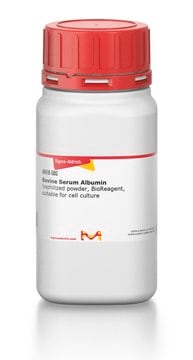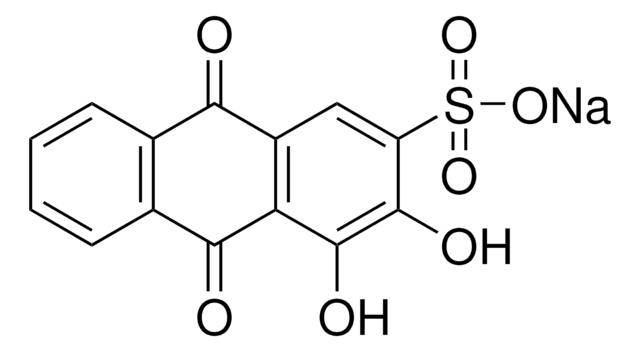AB139
Anti-Glycine Antibody
serum, Chemicon®
Faça loginpara ver os preços organizacionais e de contrato
About This Item
Código UNSPSC:
12352203
eCl@ss:
32160702
NACRES:
NA.41
Produtos recomendados
fonte biológica
rabbit
Nível de qualidade
forma do anticorpo
serum
tipo de produto de anticorpo
primary antibodies
clone
polyclonal
reatividade de espécies
rat
fabricante/nome comercial
Chemicon®
técnica(s)
immunohistochemistry: suitable
Condições de expedição
dry ice
modificação pós-traducional do alvo
unmodified
Especificidade
Glycine
The cross-reactivities were determined using either ELISA or RIA techniques, at concentration/unconjugated or conjugated amino acid concentration at half displacement.
Compound Cross-reactivity
Glycine-G-BSA 1
Beta Alanine-G-BSA 1/100
GABA-G-BSA 1/500
Taurine-G-BSA 1/1000
Aspartate-G-BSA 1/20000
Glutamate-G-BSA <1/20000
Glycine <1/50000
The antisera was also tested for specificity using the free-floating PAP technique on rat spinal cord.
Abbreviations:
(G) Glutaraldehyde
(BSA) Bovine Serum Albumin
The cross-reactivities were determined using either ELISA or RIA techniques, at concentration/unconjugated or conjugated amino acid concentration at half displacement.
Compound Cross-reactivity
Glycine-G-BSA 1
Beta Alanine-G-BSA 1/100
GABA-G-BSA 1/500
Taurine-G-BSA 1/1000
Aspartate-G-BSA 1/20000
Glutamate-G-BSA <1/20000
Glycine <1/50000
The antisera was also tested for specificity using the free-floating PAP technique on rat spinal cord.
Abbreviations:
(G) Glutaraldehyde
(BSA) Bovine Serum Albumin
Imunogênio
Glycine-gluteraldehyde-BSA
Aplicação
Immunohistochemistry: 1:500-1:2,500 by PAP (see suggested protocol).
Optimal working dilutions must be determined by the end user.
Optimal working dilutions must be determined by the end user.
Research Category
Neuroscience
Neuroscience
Research Sub Category
Neurotransmitters & Receptors
Neurotransmitters & Receptors
This Anti-Glycine Antibody is validated for use in IH for the detection of Glycine.
forma física
Rabbit antiserum. Liquid with 0.05% sodium azide.
Armazenamento e estabilidade
Maintain at -20°C in undiluted aliquots for up to 6 months after date of receipt. Avoid repeated freeze/thaw cycles.
Informações legais
CHEMICON is a registered trademark of Merck KGaA, Darmstadt, Germany
Exoneração de responsabilidade
Unless otherwise stated in our catalog or other company documentation accompanying the product(s), our products are intended for research use only and are not to be used for any other purpose, which includes but is not limited to, unauthorized commercial uses, in vitro diagnostic uses, ex vivo or in vivo therapeutic uses or any type of consumption or application to humans or animals.
Não está encontrando o produto certo?
Experimente o nosso Ferramenta de seleção de produtos.
Código de classe de armazenamento
10 - Combustible liquids
Classe de risco de água (WGK)
WGK 2
Certificados de análise (COA)
Busque Certificados de análise (COA) digitando o Número do Lote do produto. Os números de lote e remessa podem ser encontrados no rótulo de um produto após a palavra “Lot” ou “Batch”.
Já possui este produto?
Encontre a documentação dos produtos que você adquiriu recentemente na biblioteca de documentos.
Interruption of pacemaker signals is mediated by GABAergic inhibition of the pacemaker nucleus in the African electric fish Gymnarchus niloticus.
Ying Zhang, Masashi Kawasaki
Journal of comparative physiology. A, Neuroethology, sensory, neural, and behavioral physiology null
S McDavid et al.
Neuroscience, 139(3), 1049-1059 (2006-03-15)
Three series of experiments were carried out to characterize interneurons located within the trigeminal motor nucleus of young rats aged 5-24 days. Cholera toxin injections were made bilaterally into the masseter and, sometimes, digastric muscles to label motoneurons. In the
Atsuo Nishino et al.
BMC neuroscience, 11, 6-6 (2010-01-21)
Rhythmic motor patterns for locomotion in vertebrates are generated in spinal cord neural networks known as spinal Central Pattern Generators (CPGs). A key element in pattern generation is the role of glycinergic synaptic transmission by interneurons that cross the cord
Heterogeneous kinetics and pharmacology of synaptic inhibition in the chick auditory brainstem.
SP Kuo, LA Bradley, LO Trussell
The Journal of Neuroscience null
J H Lue et al.
Synapse (New York, N.Y.), 41(2), 139-149 (2001-06-16)
This study was aimed to clarify whether the primary afferent terminals (PATs), GABAergic terminals, and glutamatergic terminals made direct synaptic contacts with glycine-IR neurons in the cuneate nucleus of rats. In this connection, injection of the anterograde tracer WGA-HRP into
Nossa equipe de cientistas tem experiência em todas as áreas de pesquisa, incluindo Life Sciences, ciência de materiais, síntese química, cromatografia, química analítica e muitas outras.
Entre em contato com a assistência técnica






